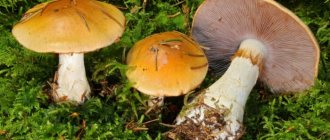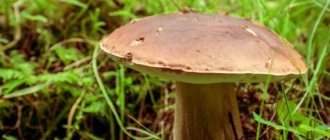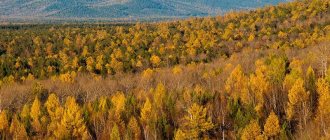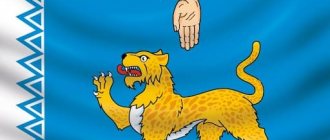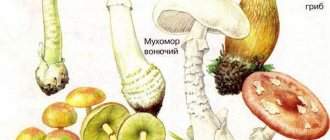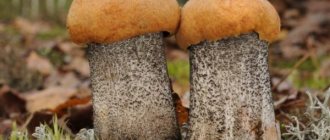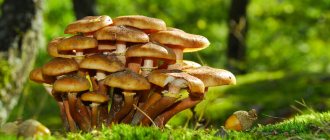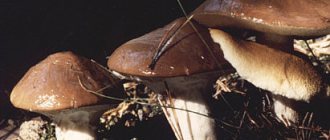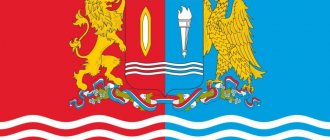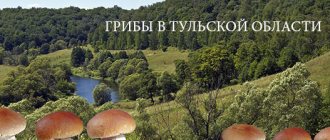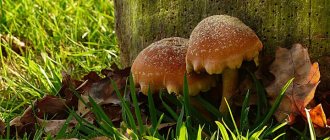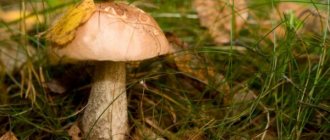Central Russia, rich in mushroom harvests, always treats visitors with edible gifts. But if not all regions can boast of large areas of tree planting, mushroom places in the Nizhny Novgorod region in 2022 are distinguished by long-lasting deciduous and coniferous areas, which are storehouses of mushrooms. Moderate temperatures corresponding to each season allow spring, summer, autumn and even winter families to germinate, delighting local residents with the opportunity to go on a quiet hunt.
Before going to the mushroom pantry, you should take seriously the reviews of mushroom pickers who leave their impressions of the latest mushroom hunt on social networks and forums. From the information over the last week, you can form a conclusion about the fruiting of certain species, the best directions or places to go by bus or car, and most importantly, answer the common question - “Are there mushrooms in the forest today?”
Where do mushrooms grow? Mushroom places with coordinates on the map
Despite the richness of forest plantings, lovers of quiet hunting prefer time-tested mushroom places located in the area. The list of destinations includes not only districts, but also villages:
1) Borsky and Gorodetsky districts;
2) Tarasikha;
3) forest belt on the road to Semenov;
4) the village of Lukino;
5) Voskresensky district, remote from the city at a distance of 110 km.
Alternative options, famous for their mushroom pantries in the past few years, remain: Berezovaya floodplain, Lukino, Kerzhenetsky forest, the territory of Lake Svetloyar.
Depending on the trees growing in the forest, the harvest may vary. Breeds of mushrooms never bear fruit in one place and month. Edible fruits replace each other, offering the mushroom picker to choose one or more options from a huge assortment. A germination chart for each family should help determine when is the best time to start hunting for food.
The most popular mushrooms growing in the Nizhny Novgorod region remain those whose fruiting implies a double or even triple harvest. The large volume of germination makes families more discussed on forums and social networking groups. We are talking about such species as: boletuses (boletus and boletus), honey mushrooms, rows, russula, champignon family and milk mushrooms. To find the latter, you should go searching in the wide forests stretching across two districts: Urensky and Krasnobakovsky. Thanks to the sprouting deciduous and coniferous trees, the volume of the harvest increases, allowing every local resident to collect not only white and black milk mushrooms, but also chanterelles, boletus and even saffron milk caps.
Fans of chanterelles, which stand out from green landscapes due to their color and are known for their unique nutty-fruit aroma and delicate flesh, should highlight the Borsky district as a priority on the map. According to reviews on the local forum, harvesting these mushrooms in this place is much easier than in the forest belts nearby the city.
Mushroom pickers who collect honey mushrooms for food and pickling should give preference in choosing the best place to the village of Lisya Griva, located at a distance of 45-47 km, depending on the starting point. Many autumn subspecies sprout there, and sometimes even meadow honey mushrooms are found.
To the mushroom camp! The second – autumn – layer is already on its way
In Russia, the organizations FBK (Foundation for Fighting Corruption, recognized as a foreign agent), Navalny's Headquarters, National Bolshevik Party, Jehovah's Witnesses, Army of the People's Will, Russian National Union, Movement Against Illegal Immigration are recognized as extremist and banned. ", "Right Sector", UNA-UNSO, UPA, "Trizub named after. Stepan Bandera", "Misanthropic Division", "Mejlis of the Crimean Tatar People", the "Artpodgotovka" movement, the all-Russian political party "Volya", AUE. Recognized as terrorist and banned: "Taliban Movement", "Caucasus Emirate", "Islamic State" (IS, ISIS), Jabhad al-Nusra, "AUM Shinrikyo", "Muslim Brotherhood", "Al-Qaeda in the Islamic Maghreb" ", "Net". In the Russian Federation, the activities of “Open Russia” and the publication “Project Media” have been recognized as undesirable. The following media are recognized as foreign agents: Dozhd TV channel, Meduza, Important Stories, Voice of America, Radio Liberty, The Insider, Mediazona, OVD-info. The society/, “Analytical Center of Yuri Levada”, Sakharov Center are recognized as foreign agents.
Non-profit organizations recognized as “foreign agents”: ANO for the implementation of socio-legal programs “Lilith”, Association for promoting the protection of the rights of conscripts, alternative servicemen and military personnel “Human rights group “Citizen.Army.Pravo””, ANO “Nizhny Novgorod Center of German and European Culture” ", Ivanovo regional public organization "Center for Gender Research", Perm regional public organization for the support and development of media projects "Fourth Sector", Non-profit organization "Fund for the Protection of Citizens' Rights "Stab", ANO "Institute of Law and Public Policy", ANO for promoting the dissemination of modern educational programs “Laboratory of Social Sciences”, Non-profit organization “Foundation for the Fight against Corruption”, Interregional Professional Union of Health Workers “Alliance of Doctors”, ANO “Center for Working with the Problem of Violence “VIOLENCE.NET””, Krasnoyarsk regional public organization “We are against AIDS”, Non-profit organization “Fund for the Protection of Citizens’ Rights”, Program-targeted Charitable Foundation “SVECHA”, St. Petersburg Charitable Foundation “Humanitarian Action”, Interregional public organization for the implementation of social and educational initiatives and educational projects “Open Petersburg”, Social oriented ANO promoting prevention and protecting the health of citizens “Phoenix PLUS”, Foundation for promoting legal education of the population “League of Voters”, Non-profit Organization “Legal Initiative” Foundation, ANO information and legal, Non-profit organization “Foundation for the Fight against Corruption”, Penza Regional Public Charitable Foundation “ Civil Union", Ingush Republican Branch of the All-Russian Public Organization "Russian Red Cross", Public Organization "Saratov Regional Jewish Charitable Center "Hasdei Yerushalayim" (Mercy), Private Institution "Center for Support and Promotion of Media Development", Regional Public Organization for Assistance respect for human rights “Hotline”, Foundation “In Defense of the Rights of Prisoners”, ANO “Institute of Globalization and Social Movements”, ANO for counteracting the HIV/AIDS epidemic and protecting the health of socially vulnerable groups of the population “Center for Social and Information Initiatives Action”, Chelyabinsk Regional diabetic social movement "TOGETHER", Charitable Foundation for the protection of health and protection of the rights of citizens, Charitable Foundation for assistance to prisoners and their families, City Charitable Foundation "Togliatti Fund", Sverdlovsk Regional Public Foundation for Social Projects "New Time", Foundation for Sustainable Development "Silver Taiga", Foundation promoting the development of mass communications and legal education “Tak-Tak-Tak”, Regional public organization for promoting the education of citizens “Information and Analytical Center “Sova””, Regional public organization for helping women and children in crisis situations “Information and Methodological Center Anna” , ANO for social support of the population “Project April”, Regional Charitable Foundation “Samara Province”, Sverdlovsk Regional Public Foundation “Era of Health”, International public organization “International Historical, Educational, Charitable and Human Rights Society “Memorial””, ANO “Analytical Center of Yuri Levada” ", ANO "Publishing House "Park Gagarin", Fund for the Promotion of Health and Social Justice named after Andrei Rylkov, Charitable Foundation for Social and Legal Assistance "Sfera", Omsk regional public organization "Center for Health and Social Protection "SIBALT"", Chelyabinsk regional authority public amateur activities "Ural Human Rights Group", Chelyabinsk regional body of public amateur activities - women's public association "Women of Eurasia", City public organization "Ryazan Historical, Educational and Human Rights Society "Memorial" (Ryazan Memorial)", City public organization "Ekaterinburg Society "MEMORIAL" “”, ANO “Institute of Human Rights”, Non-profit organization “Glasnost Defense Foundation”, Regional public scientific and information institution, Union of public associations “Russian Research Center for Human Rights”, ANO “Far Eastern Center for the Development of Civil Initiatives and Social Partnership”, Public organization "Perm Regional Human Rights Defender", ANO "Center for Independent Sociological Research", Sverdlovsk regional public organization "Sutyazhnik", NOU of additional professional education (advanced training) for specialists "Academy of Human Rights", Private institution in Kaliningrad for administrative support for the implementation of programs and projects of the Council Ministers of the Northern Countries, Interregional Charitable Public Organization "Center for the Development of Non-Profit Organizations", Regional Public Charitable Organization for Assistance to Refugees and Migrants "Civic Assistance", Autonomous Non-Profit Organization "Center for Anti-Corruption Research and Initiatives "Transparency International-R"", Regional Foundation "Center for Protection media rights", NP "Press Development Institute - Siberia", "Private institution in St. Petersburg for administrative support for the implementation of programs and projects of the Council of Ministers of the Nordic Countries", Interregional public organization Information and Educational, Press Freedom Support Foundation, St. Petersburg public human rights organization "Civil Control", Interregional public human rights organization "Man and the Law", Regional public organization "Public Commission for the Preservation of the Heritage of Academician Sakharov", Private institution "Information Agency MEMO.RU", NP "Institute of Regional Press", Foundation " Institute for the Development of Freedom of Information", Interregional public organization Human Rights, Kaliningrad regional public organization "Ecodefense!-Women's Council", Foundation for Assistance to the Protection of Rights and Freedoms of Citizens "Public Verdict", Eurasian Antimonopoly Association. Media recognized as “foreign agents”: Voice of America, Idel.Realii, Kavkaz.Realii, Crimea.Realii, Present Time TV Channel, Tatar-Bashkir Service of Radio Liberty (Azatliq Radiosi), Radio Free Europe/Radio Liberty (PCE/PC ), Siberia.Realii, Factographer, North.Realii, Radio Free Europe/Radio Liberty LLC, Czech news agency "MEDIUM-ORIENT", Meduza, First Anti-Corruption Media LLC, VTimes Internet resource, The Insider, TV Channel LLC Rain, Legal entity Istories fonds, Altair 2021 LLC, Daisies monolith LLC, Chief Editor 2021 LLC, Vega 2021 LLC, Important Foreign Agents LLC, ZP LLC, Zona Prava LLC, LLC “JOURNALIST- FOREIGN AGENT”, LLC “MEMO”, “Mason GES Anonymous Foundation” (USA), which is the owner of the online publication https://mnews.world/, ANO for the protection of human rights and informing the population “Yakutia - Our Opinion” ", LLC "Moscow Digital Media", JSC "RS-Balt", LLC "As if Inagent", Foundation for the Development of Book Culture "Irkutsk Union of Bibliophiles", LLC "Honest Elections", LLC "Nobel Appeal". Individuals recognized by the media - “foreign agents”: Gelman Marat Aleksandrovich, Shenderovich Viktor Anatolyevich, Belyaev Ivan Mikhailovich, Vladykina Elena Sergeevna, Bekbulatova Taisiya Lvovna, Tolokonnikova Nadezhda Andreevna, Nikulshina Veronika Yuryevna, Alekseev Andrey Viktorovich, Ponomarev Lev Aleks Seeval , Markelov Sergey Evgenievich, Kamalyagin Denis Nikolaevich, Apakhonchich Daria Alexandrovna, Badanin Roman Sergeevich, Glikin Maxim Alexandrovich, Manyakhin Petr Borisovich, Yarosh Yulia Petrovna, Churakova Olga Vladimirovna, Zheleznova Maria Mikhailovna, Lukyanova Yulia Sergeevna, Maetnaya Elizaveta Vitalievna, Rubin Mikhail Arkadievich , Groysman Sofya Romanovna, Rozhdestvensky Ilya Dmitrievich, Apukhtina Yulia Vladimirovna, Posternak Alexey Evgenievich, Petrov Stepan Yurievich, Shmagun Olesya Valentinovna, Marokhovskaya Alesya Alekseevna, Dolinina Irina Nikolaevna, Shleinov Roman Yurievich, Anin Roman Alexandrovich, Velikovsky Dmitry Alexandrovich, Katkova Veronika V Yacheslavovna, Karezina Inna Pavlovna , Kuzmina Lyudmila Gavrilovna, Kostyleva Polina Vladimirovna, Lyutov Alexander Ivanovich, Zhilkin Vladimir Vladimirovich, Zhilinsky Vladimir Alexandrovich, Tikhonov Mikhail Sergeevich, Piskunov Sergey Evgenievich, Kovin Vitaly Sergeevich, Kiltau Ekaterina Viktorovna, Lyubarev Arkady Efimovich, Gurman Yuri Albertovich, G Rezev Alexander Viktorovich, Vazhenkov Artem Valerievich, Ivanova Sofia Yuryevna, Pigalkin Ilya Valerievich, Petrov Alexey Viktorovich, Egorov Vladimir Vladimirovich, Gusev Andrey Yuryevich, Smirnov Sergey Sergeevich, Verzilov Peter Yuryevich, Voltskaya Tatyana Anatolyevna, Klepikovskaya Ekaterina Dmitrievna, Sotnikov Daniil Vladimirovich, Zakharov Andre y Vyacheslavovich, Simonov Evgeniy Alekseevich , Surnacheva Elizaveta Dmitrievna, Solovyova Elena Anatolyevna, Arapova Galina Yuryevna, Pearl Roman Alexandrovich, Conspiracy Maxim Alexandrovich, Vetoshkina Valeria Valerievna, Pavlov Ivan Yurievich, Skvortsova Elena Sergeevna, Olenichev Maxim Vladimirovich, Kochetkov Igor Viktorovich, Elanchik Oleg Alexandrovich, Gri Gor'eva Alina Aleksandrovna, Grigoriev Andrey Valerievich, Regina Emilevna Gimalova, Regina Faritovna Khisamova, Unregistered public associations recognized as “foreign agents”: Far Eastern public movement “Mayak”, St. Petersburg LGBT initiative group “Coming Out”, LGBT+ initiative group “Reverse”, All-Russian public movement in defense of the rights of voters “Voice”, Media project “OVD-Info”, Interregional public movement “Russian LGBT Network”.
By car or bus, which is the best way to get there?
When choosing transport, not only the availability of a personal car is taken into account, but also the distance of the route, comfort, the planned volume of collection and the time spent in the forest. When going on multi-kilometer trips that take at least 1.5-2 hours, you should give preference to a car. Due to the precise schedule of intercity transport, the mushroom picker may not be able to get to the stop in time to go back home. As a result, you will have to spend extra money on calling a taxi or the nerves of braking a ride moving in the right direction. It’s another matter if the collection point is located within the city and can be reached at any time. If you don’t feel discomfort when riding a minibus, you can try to get to the point without getting behind the wheel.
Regardless of which method the mushroom picker chooses, if you don’t know the area, you should take a compass or GPS navigator with you. With their help, you won't be able to get lost and lose your car. The main thing is not to forget to put a point so that you can easily get out of the dense thicket along it.
For people who prefer to take risks when going on long trips by bus, it is recommended to choose early departure times. Such a trick will become a lifeline if a person misses the necessary bus on the way back home. Daytime will save nerves, leaving options for alternative solutions.
Get to know me
Before you go on a “silent hunt”, you should study not only general information about mushroom places, but also what edible mushrooms look like.
- Boletus (or porcini mushroom) can be found in almost any forest: both in a pine forest and in a birch grove. Depending on where it grows, the color of its cap changes. It can be either yellow or brown. Its leg usually resembles a cylinder, thickened at the bottom.
- The cap of the boletus is painted whitish-gray. True, his headdress often changes color depending on the area in which the fungus grew. But the bottom of the cap is always white and porous. The stem of the boletus is cylindrical, slightly thickened at the bottom.
- The boletus looks like a bullfinch - its cap is bright red or orange, and its leg is gray. It also becomes thicker near the ground.
- Butterflies have a light brown oil cap. Often, due to excessive oiliness, leaves stick to the cap, and then the mushroom is difficult to find. The bottom of the “headdress” is lemon yellow, its surface is porous, like a sponge.
- The breast looks like a funnel with the edges turned down, it is usually white. Salted milk mushrooms are very good, but they must first be soaked so that it releases excess moisture and mucus located in the center of the cap.
- Camelina grows in deciduous forests or under pine trees. The shape of its “headdress” depends on the age of the saffron milk cap: when the mushroom is young it is small and convex, then it is pressed inward and takes on the shape of a funnel. The cap is bluish-green or orange.
- Champignons are bred in greenhouses under artificial conditions. So you won't find them in the forest.
- Honey mushrooms are one of the most favorite mushrooms of forest hunters. They grow in families; if you find one honey mushroom, it is likely that you can cut up a whole basket of its family with it. This fungus usually grows on rotting trees in high humidity. The color of the honey mushroom cap is usually yellow or light brown, the leg is thin and graceful. Honey mushrooms are wonderful when pickled. But some mushroom pickers fry them, cutting off the stems, which can be a little tough when prepared in this way.
- Chanterelles are considered the royal mushroom. They cannot be confused with a poisonous mushroom. So, their appearance is unique. They are red or light yellow and grow in the shape of funnels with small legs. Chanterelles, like honey mushrooms, are a godsend for mushroom pickers, as they grow in whole families.
- Russulas are the most fun mushrooms to color. Their cap can be any color: white, red, green, yellow. They grow in deciduous forests and are the most common mushrooms. In order not to confuse russula with toadstool, you need to look under the cap of the mushroom; if it has a “skirt”, then you should not take it - it is poisonous.
Where to collect mushrooms? Forum tips
Most local residents who are keen on quiet hunting know firsthand about the forum and communities on social networks, where many talk about proven directions for collecting mushrooms, and even leave exact coordinates. Useful information allows you to independently answer where to collect mushrooms in the Nizhny Novgorod region in 2022, and which of the forests will be most suitable for this purpose.
Even if the weather does not allow you to collect noble breeds, russula and rowed grass, which grow in the Urensky and Krasnobakovsky districts, always remain as an alternative. From summer to late autumn, fruiting continues due to the increased humidity associated with nearby bodies of water.
It is much easier to detect oyster mushrooms, champignons and milk mushrooms in mixed forests where different types of trees grow. Preference should be given to old plantings, where there are clearings and rotten stumps, the favorites of most fungi, whose mycelium infects trunks hidden under the bark.
Places near Nizhny Novgorod
The map of mushroom places in the Nizhny Novgorod region begins directly from the outskirts of Nizhny Novgorod. Within a radius of several kilometers from the regional center there are few forests and they have been partially converted into parks. “Silent hunting” is possible to the south of Nizhny Novgorod in the villages:
- Peat warehouse in Sormovsky district;
- Birch Floodplain of this region;
- the village of Lukino in the Balakhninsky district.
To the north of the regional center there are small forests in the Bogorodsky and Kstovsky districts. Mushroom places in the Nizhny Novgorod region are usually reached by public transport, which runs until late in the evening.
Among the mushrooms, saffron milk caps are often found. They are found directly under a deciduous or coniferous tree. The young fruit body has a convex blue-green cap, which at the time of collection is funnel-shaped orange.
Mushroom pickers often collect honey mushrooms. They are recognized by their yellow-gray cap and thin brown stem.
Reviews with photos of the harvest
- Viktor Alekseevich, 71 years old
Every year I collect mushrooms in the autumn months. In spring and summer the harvest is small, so I give away the food harvest to those in need. Last year we managed to close more than 30 cans of 0.5 boletus and about 10 liters of boletus mushrooms. There was no fruit left for drying and freezing. I hope that 2022 will bring more mushrooms so that there will be enough for our grandchildren and children.
- Alexander Sergeevich, 39 years old
Most of all I love honey mushrooms, despite the complex processing and cleaning. Their taste goes well with vegetables and herbs, and the aroma will captivate you to eat another mushroom. Since the beginning of spring, I have already managed to remove several buckets of spring and meadow subspecies from the forest. Now I'm waiting for autumn...
